The
question of the origin of the ancestors with the family name RITTMEYER
or RITTMEIER has already occupied many family researchers of the
family. It was also not infrequently asked whether all RITTMEYERs or
RITTMEIERs are related to each other and descend from a common early
ancestor.
This question is easy to answer, all RITTMEYERs or RITTMEIERs have no
common ancestor and are, if at all, only regionally related. Surnames
were formed for the first time at all in the 13th and 14th centuries
and their recording in registers did not begin until the 15th and 16th
centuries (see History
of Surname). The family name RITTMEYER or RITTMEIER was
formed according to the local
location of the villikation (special form of landlordship
in the Middle Ages) or the lathufe or the soil conditions. Ried or also Riet stands for Ried
(small reed) of moor
areas and swamps,
accordingly our ancestors will have lived in regions with moor areas
and swamps at the time of the name formation.
The family name RITTMEYER and its variants is therefore a typical
example that the family name had not only a regional origin, but had
formed to a large extent at the same time in many regions. From the DNA
research it is in the meantime securely known that there are at least 4
of each other completely independent descents, which carry variants of
the family name RITTMEYER. In the meantime there are findings about at
least 4 haplogroups
of probands,
which originate mainly from Eichsfeld (I-M170), Lower
Saxony (not Eichsfeld) and North Rhine-Westphalia (R-M269), Bavaria (I-M253) as well as
East Prussia and Lithuania (R-M198).
Relationships between probands of different haplogroups can basically
be excluded.
|
|
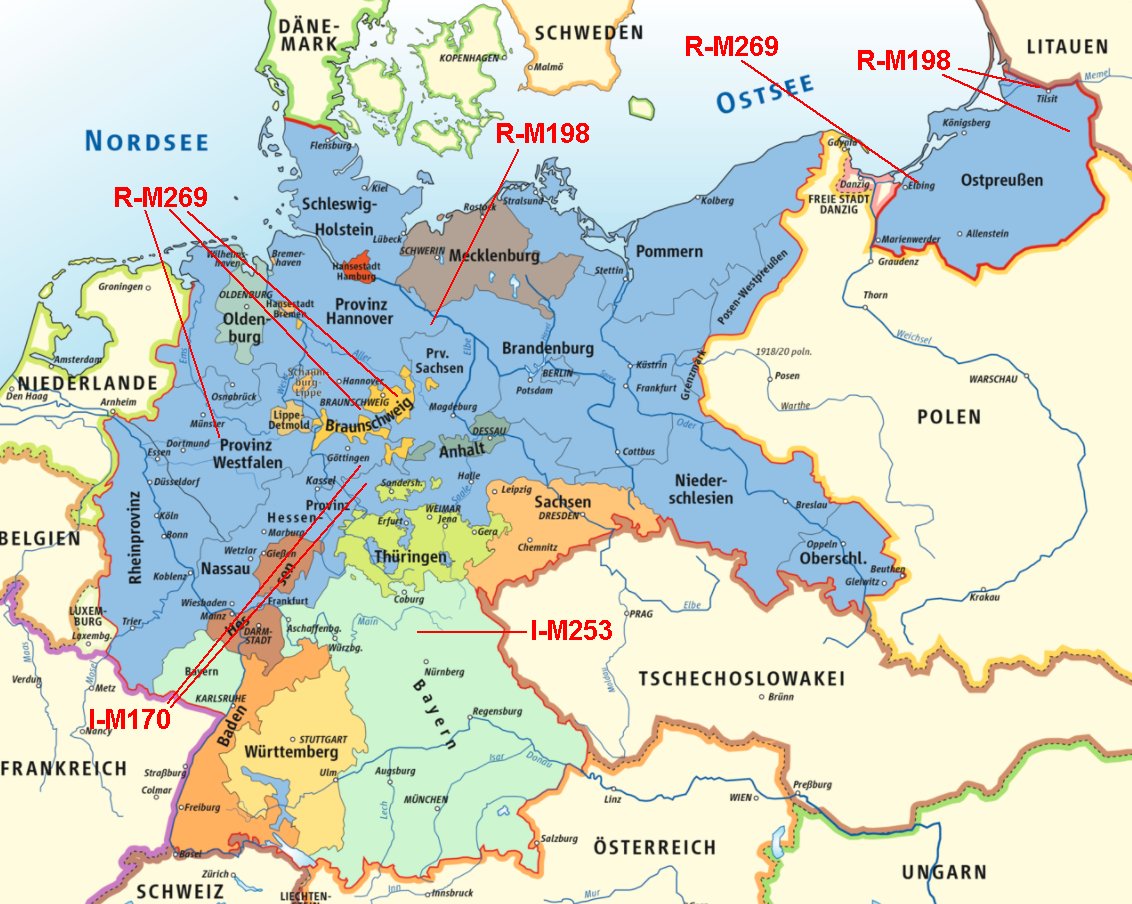 |
Regional distribution of the haplogroup of
families with the surname RITTMEYER / RITTMEIER
|
Haplogroups
are used to define genetically related groups of people within
populations. All members of the same haplogroup can be traced back to a
common ancestor. Haplogroups can be thought of as large branches of the
Homo Sapiens family tree. Each haplogroup groups together people whose
genetic profile is similar and who share a common ancestor. In this
case, males belong to a haplogroup of the Y chromosome who have a
common ancestor in a purely paternal line. The Y chromosome is always
passed from father to son.
These haplogroup branches show how population groups have moved across
the earth. So haplogroups also define a geographic area. Older
haplogroups are larger and more widespread, and numerous younger
subgroups (subclades) descend from them.
With the help of a tool from Rob Spencer (SNP-Tracker)
graphics were generated for the 4 relevant haplogroups. The following
graphs show impressively that probands with different haplogroups
cannot be related to each other a priori, although they all have the
same surname (exception for illegitimate births, where ancestors have
continued the surname of the mother):
- Common
haplogroups until HIJK-PF3494
(57,000 years ago), then regional separation.
- Migration of
haplogroups R-M198
(14,000 years ago) and R-M269
(13,000 years ago) to the east and from haplogroup P-P226 (35,000 years
ago) to the west, further mutations after haplogroup R-M173 (23,000 years
ago) in two directions
- Migration
peoples groups haplogroup I-M170
(43,000 years ago) immediately to the west and further development in
haplogroup I-M253
(28,000 years ago) in the direction of north-west.
|
|
| The following project members
signed up for a DNA test at the genealogy portal FamilyTreeDNA
and also performed a Y test to determine their respective haplogroup. |
|
| Haplo |
DNA-Test |
FTDNA Id |
GEDMatch Id |
Alias Name |
Last Name, First Name |
Country |
Origin Region |
Origin Location |
| I-M170 |
Y-37 |
763741 |
T794547 |
WIN_Pete40 |
Rittmeyer, Peter |
DEU |
Thüringen |
Wingerode |
| R-M198 |
Y-37 |
757756 |
T550253 |
LIT_Olaf69 |
Rittmeier, Olaf |
DEU |
Litauen |
|
| R-M198 |
Y-37 |
754518 |
T179407 |
LIT_Manf49 |
Rittmeyer, Manfried |
DEU |
Litauen |
|
| R-M269 |
Y-37 |
745969 |
T106463 |
MÜN_Wern65 |
Rittmeier, Werner |
DEU |
Nordrhein-Westfalen |
Ahlen |
| R-M269 |
Y-37 |
IN16382 |
T964875 |
MÜN_Uwe56 |
Rittmeier, Uwe |
DEU |
Nordrhein-Westfalen |
Hamm |
| I-M170 |
Y-37 |
IN15278 |
T385240 |
NES_Stef60 |
Rittmeier, Stefan |
DEU |
Niedersachsen |
Nesselröden |
| R-M269 |
Y-37 |
762383 |
T883147 |
SCH_Uwe61 |
Rittmeier, Uwe |
DEU |
Niedersachsen |
Schlewecke |
| I-M253 |
Y-37 |
IN10927 |
T560231 |
STR_Rein60 |
Rittmeier, Reinhold |
DEU |
Bayern |
Bamberg |
| R-M198 |
Y-37 |
747897 |
T286036 |
KUS_Wern44 |
Rittmeyer, Werner |
DEU |
Ostpreussen |
Kussen |
| R-M269 |
Y-111 |
721392 |
T590927 |
WEK_Guen37 |
Rittmeier, Günter |
DEU |
Westpreussen |
Weklitz |
| R-M269 |
Y-37 |
725279 |
T784441 |
WEK_Klau56 |
Rittmeyer, Klaus |
DEU |
Westpreussen |
Weklitz |
| R-M269 |
Y-37 |
755638 |
T925401 |
WEK_Bern64 |
Rittmeyer, Bernd |
DEU |
Westpreussen |
Weklitz |
| R-BY72309 |
Y-111 |
700161 |
HM690708C1 |
*WEK_Lutz51 |
Rittmeier, Lutz |
DEU |
Westpreussen |
Weklitz |
| R-M269 |
Y-37 |
IN15290 |
T193421 |
MEC_Theo53 |
Rittmeier, Theo |
DEU |
Nordrhein-Westfalen |
Mechernich |
| I-M253 |
Y-37 |
IN19807 |
T035456 |
NAB_Herb53 |
Rittmeier, Herbert |
DEU |
Bayern |
Bamberg |
| R-M269 |
Y-37 |
IN52330 |
GF8913004 |
MÜN_Diet53 |
Rittmeier, Dieter |
DEU |
Nordrhein-Westfalen |
Ahlen |
| R-M269 |
Y-37 |
IN79799 |
NN7298318 |
MÜN_Hugo62 |
Rittmeier, Hugo |
DEU |
Nordrhein-Westfalen |
Ahlen |
| R-M198 |
Y-37 |
IN79805 |
ZM2273096 |
LÜC_Holg56 |
Rittmeyer, Holger |
DEU |
Niedersachsen |
Lüchow |
| R-M269 |
Y-37 |
IN79810 |
ZH8426099 |
BRA_Lutz40 |
Rittmeyer, Lutzpeter |
DEU |
Niedersachsen |
Braunschweig |
In order to be able to
determine a relationship on the paternal line, it is additionally
necessary to determine the genetic
density
of the individual probands with the same haplogroup.The evaluation
below at FamilyTreeDNA shows, for example, a sorting according to
haplogroups and thus also allows an evaluation of the relationship
based on the genetic density. In the test persons tested so far, a
relationship between 2 test persons in the haplogroup "I-M170" and 4
test persons in the haplogroup "R-M269" can therefore be confirmed
beyond doubt on the basis of the genetic density.
These evaluations were carried out for probands who registered with
FamilyTreeDNA for the surname project RITTMEIER / RITTMEYER and
performed a Y-test (min. Y-37). |

|
|
The
test persons of rows 15, 16, 17 and 18 are direct relatives of the 3rd
degree (the great-grandfathers were brothers), whose ancestors were
first recognized in 1775 in Prussian Holland (East Prussia) (kinship
confirmed by paper research and autosomal DNA). The genetic density
between the subjects confirms the kinship on the purely paternal side,
since the values are very dense with "0" or maximum "1" and therefore
leave no doubt.
|
 |
|
| WEK_Guen37 |
WEK_Bern64 |
WEK_Lutz51 |
WEK_Klau56 |
|
|
Consequently, all
4 test persons must also have the same Y-matches at
FamilyTreeDNA. The following graphs were generated for each individual
proband at FamilyTreeDNA using the "Matches
Maps" function and the "Y-DNA
12 Marker"
setting. Most of the matches at the "Y-DNA 12 marker" level are indeed
very old, since the common, genetic features date for the most part to
the Copper and Bronze
Ages (5,500-800 BC). However, in the present case, the graphs
show the close
relationship between the 4 test persons by their
absolute match of Y-matches.
Furthermore, the graphs illustrate from where the first, known
ancestors of the probands (Y-matches) originated regionally. The graphs
here impressively show the regional focus on Great Britain and Ireland as well as
the Netherlands
and West/Southwest
Germany. This regional emphasis is to be regarded as a homogeneous region
for the ancestors of the 4 probands, since the optical predominance of
Great Britain and Ireland is only due to the higher DNA test readiness
of British probands.
|
|
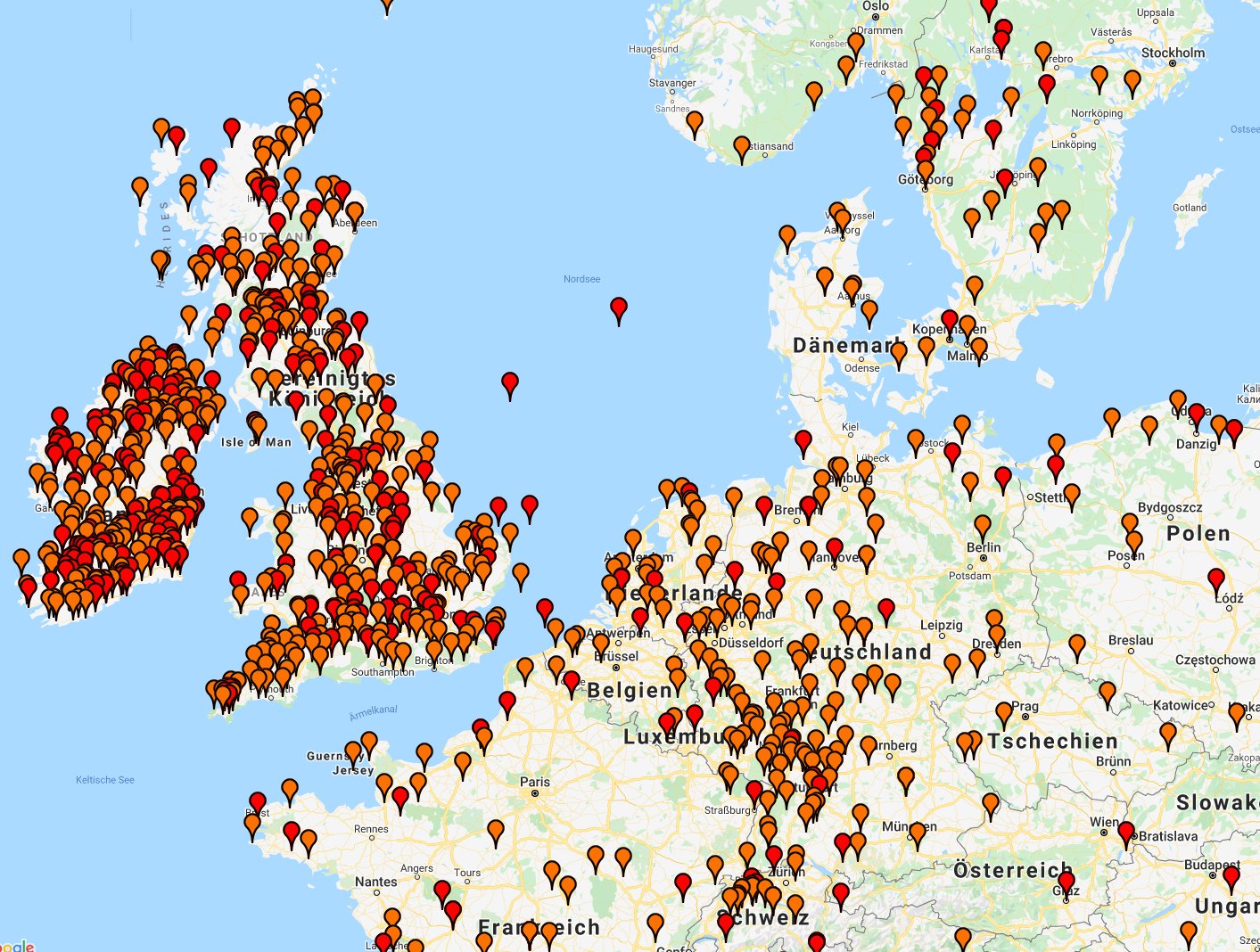 |
| WEK_Lutz51 |
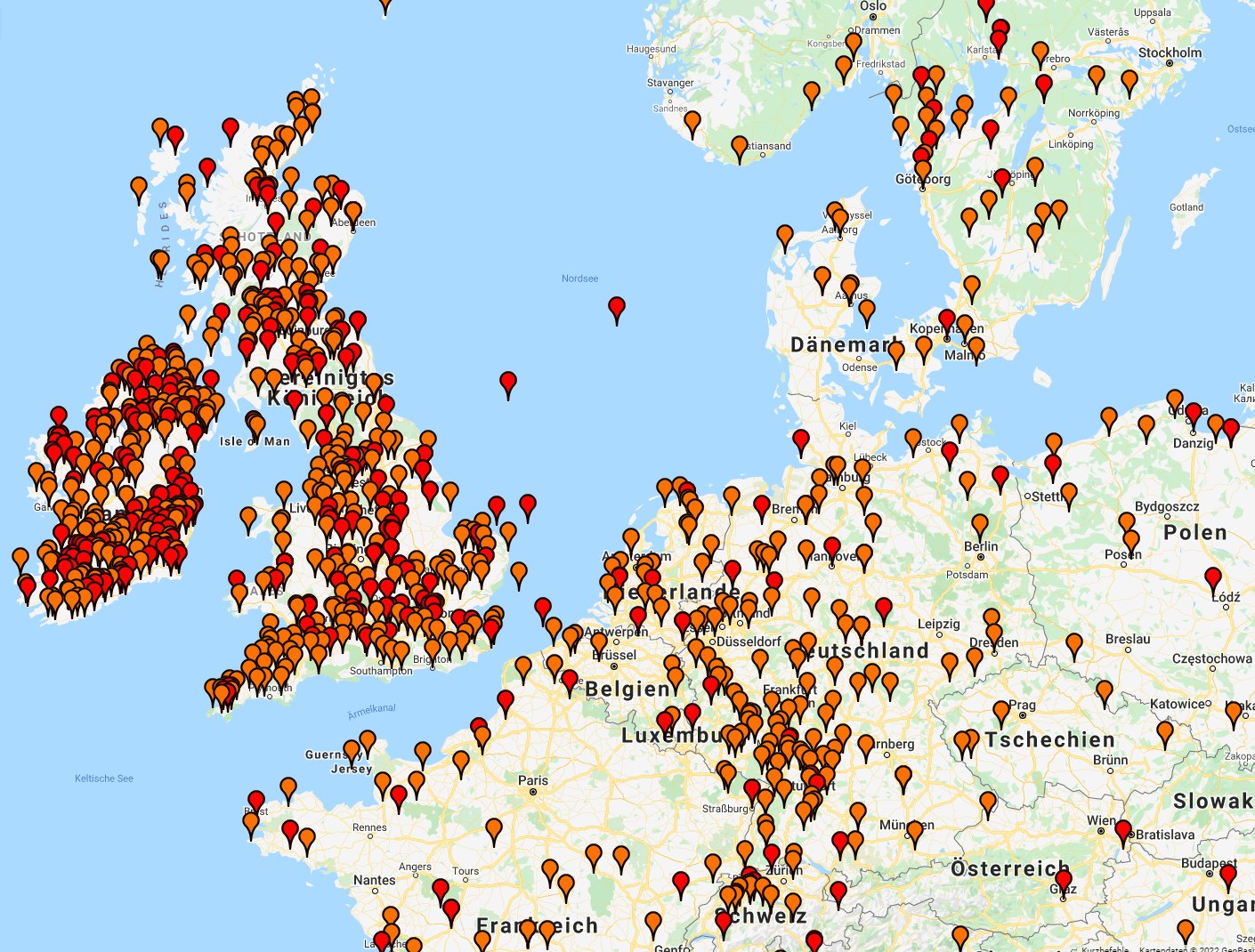 |
|
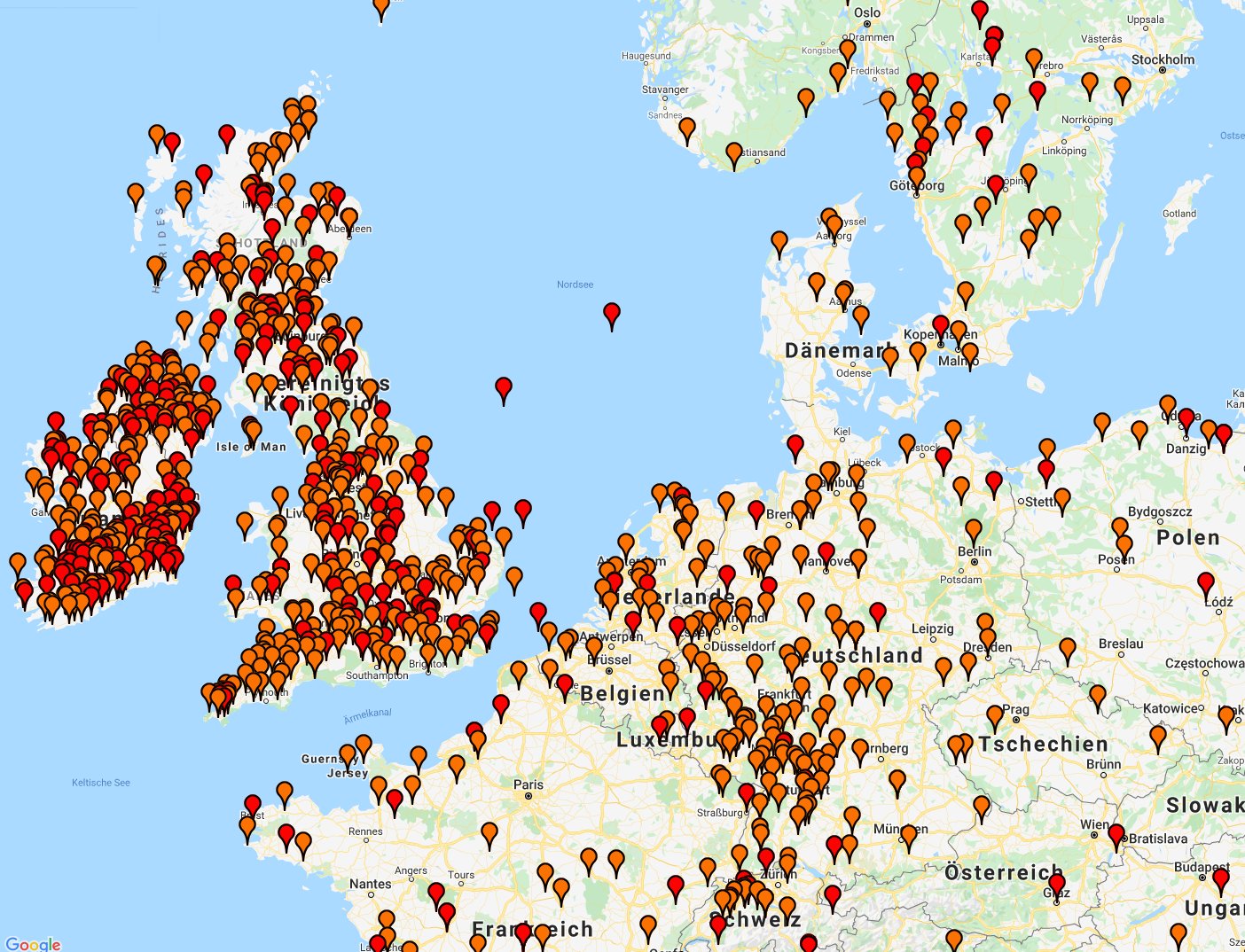 |
|
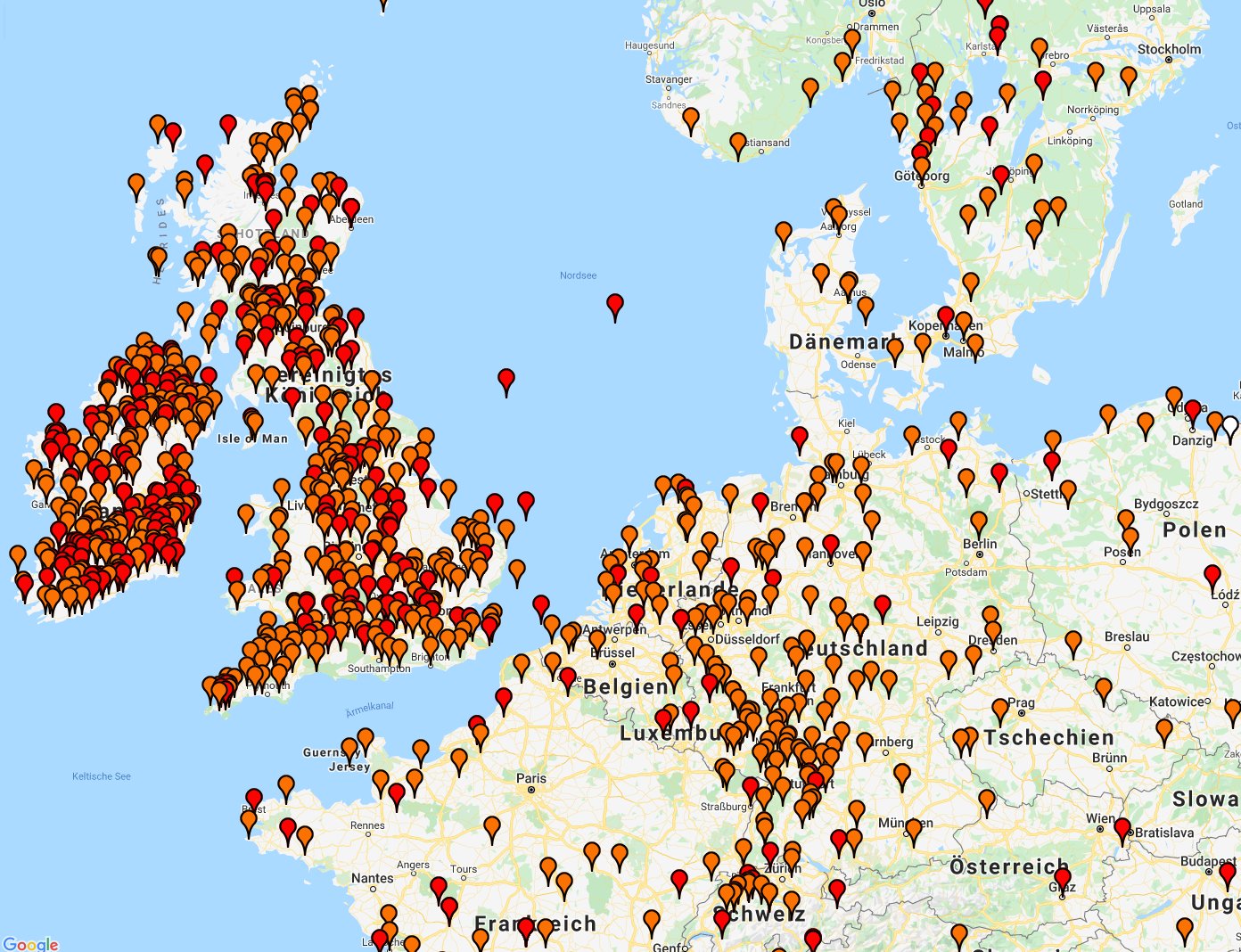 |
| WEK_Guen37 |
|
WEK_Bern64 |
|
WEK_Klau56 |
While
with the Y-tests "Y-37" and "Y-111" from FamilyTreeDNA one only gets
the above mentioned results up to the Middle Stone Age,
evaluations like BIG-Y700 from FamilyTreeDNA offer information up to
modern times. Within the scope of this project, only 2 subjects have
been evaluated so far because of the high costs. In the following, the
results are presented based on the probands in line 16 with haplogroup "R-BY72309" and line
2 with haplogroup "I-PH2591".
Graph 1 shows that the ancestors of proband "R-BY72309" were
first recognized on the present territory of Germany and the
Netherlands during the Bronze
Age about 4,700 years ago. During the following ice age 2,800
years ago until the Roman period
2,000 years ago, the further mutations developed exclusively in the
present-day regions of the east coast of England and the west coast of
the Netherlands / western Germany (see graph 1). Finally, the mutation
of the proband with haplogroup "R-BY72309" dates to about 500 AD or 1,400
years ago (see graph 2).
|
|
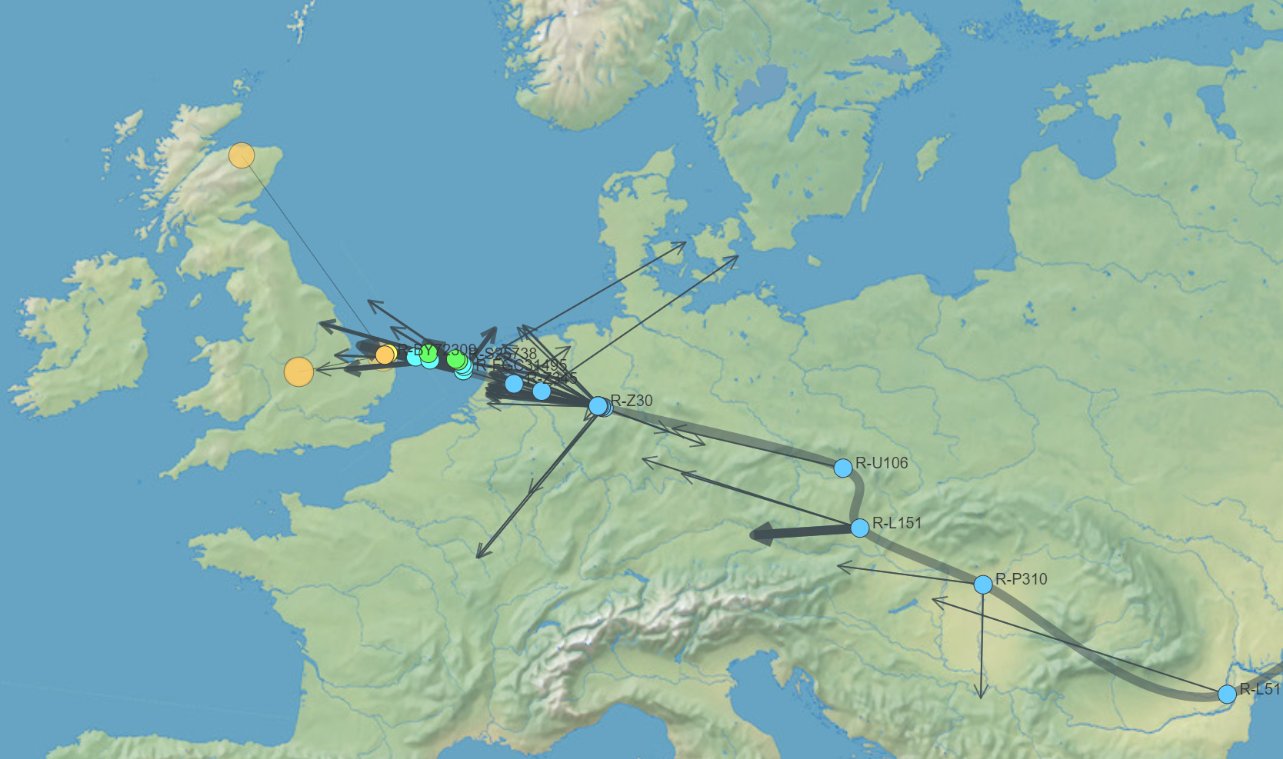 |
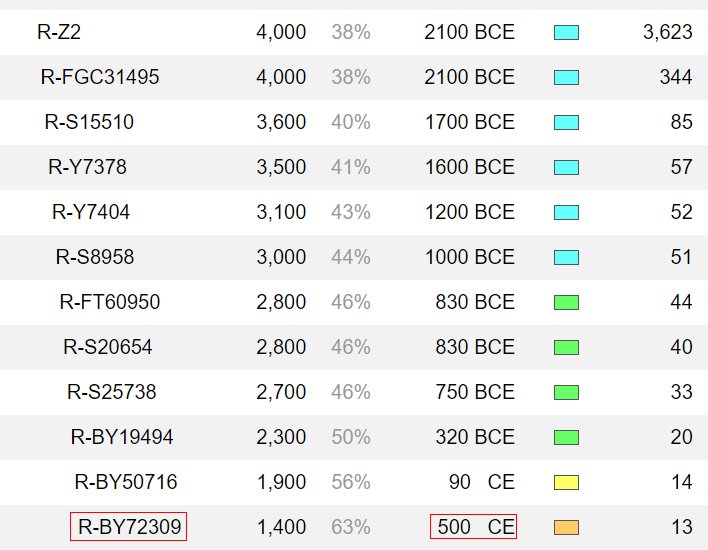 |
The mutation of
the haplogroup "R-BY72309" falls exactly in the time, in which the
Romans withdrew from 410
AD from Britain and the land seizure in the east of
Britain by the Anglo-Saxons
began. Thus the habitat of the mutant "R-BY72309" is also to be defined
with emphasis with the today's regions east coast of England and west
coast Netherlands / West Germany.
In comparison, the haplogroup "I-PH2591"
had with Central Germany a completely different target area and
justifies the high number of descendants with the surname RITTMEIER /
RITTMEYER with emphasis on Eichsfeld
both in the south of Lower Saxony, as well as in the north of
Thuringia. The haplogroup "I-PH2591" originated already 3,700 years
ago, thus 2,300 years earlier than the haplogroup "R-BY72309". The
probands in row 1 and 2 are each a descendant of RITTMEYERS from
Wingerode (Thuringia) and of RITTMEIERs from Nesselröden
(Lower
Saxony). The genetic density of the two probands is very dense with
"2". Accordingly, a common ancestry can be assumed. |
|
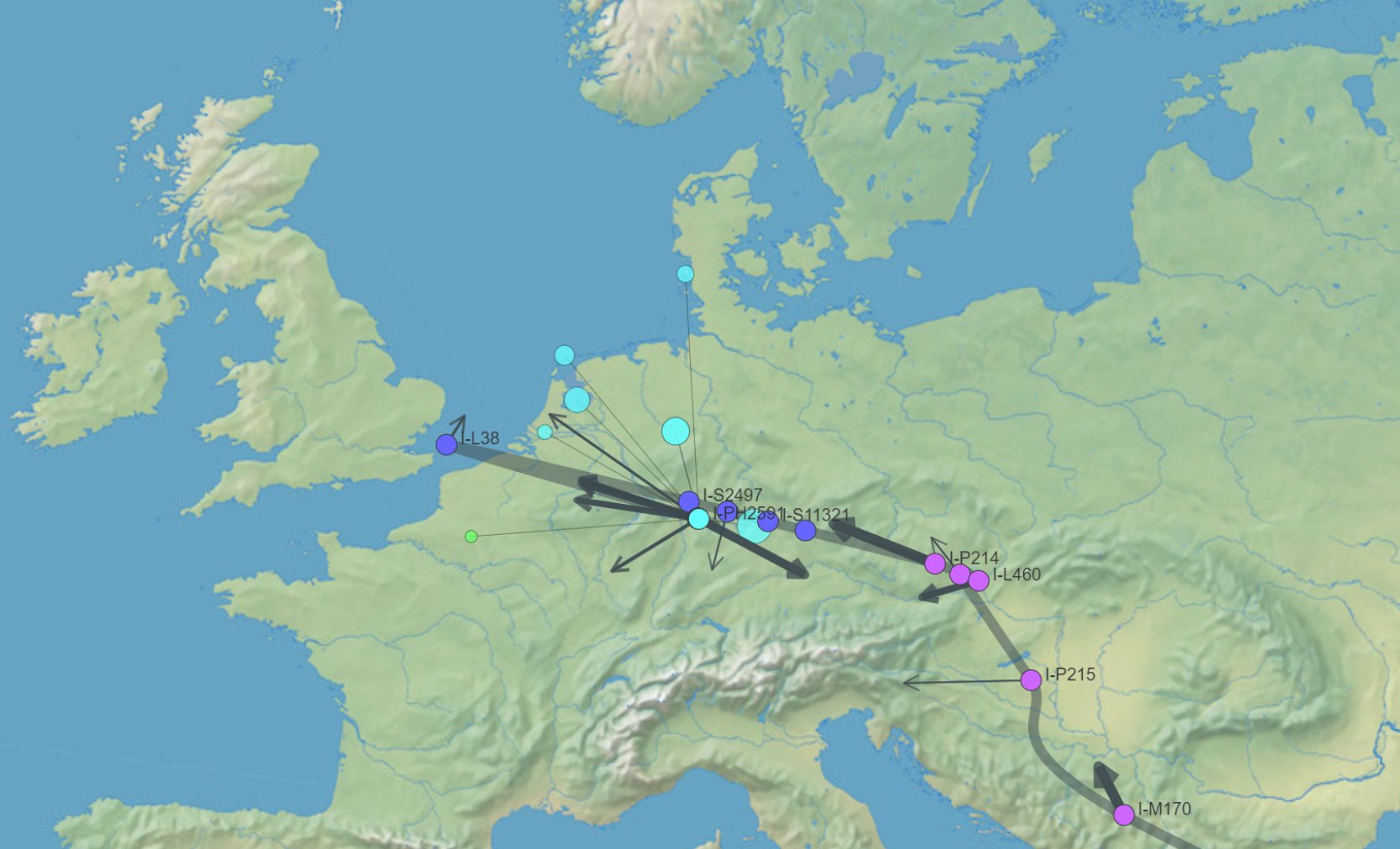 |
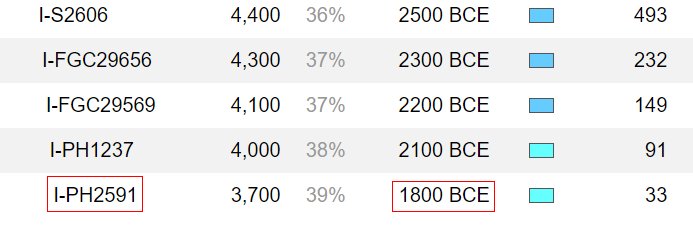 |
|
| The
following graphs were generated for the remaining test persons with
Y-test in FamilyTreeDNA with the function "Matches Maps" and
the setting "Y-DNA 12
Marker".
First of all, it is striking that all probands - with the exception of
the proband STR_Rein60 - have significantly fewer matches with other
Y-test partners than the 4 probands of the haplogroup "R-BY72309"
(see above). Between single probands the same haplogroups in
combination with partly same Y-match partners suggest -
possibly
up to the Middle Stone Age - early
common
ancestors (highlighted in different colors). |
|
| Probands Haplogroup R-M269
(Region Münsterland) |
|
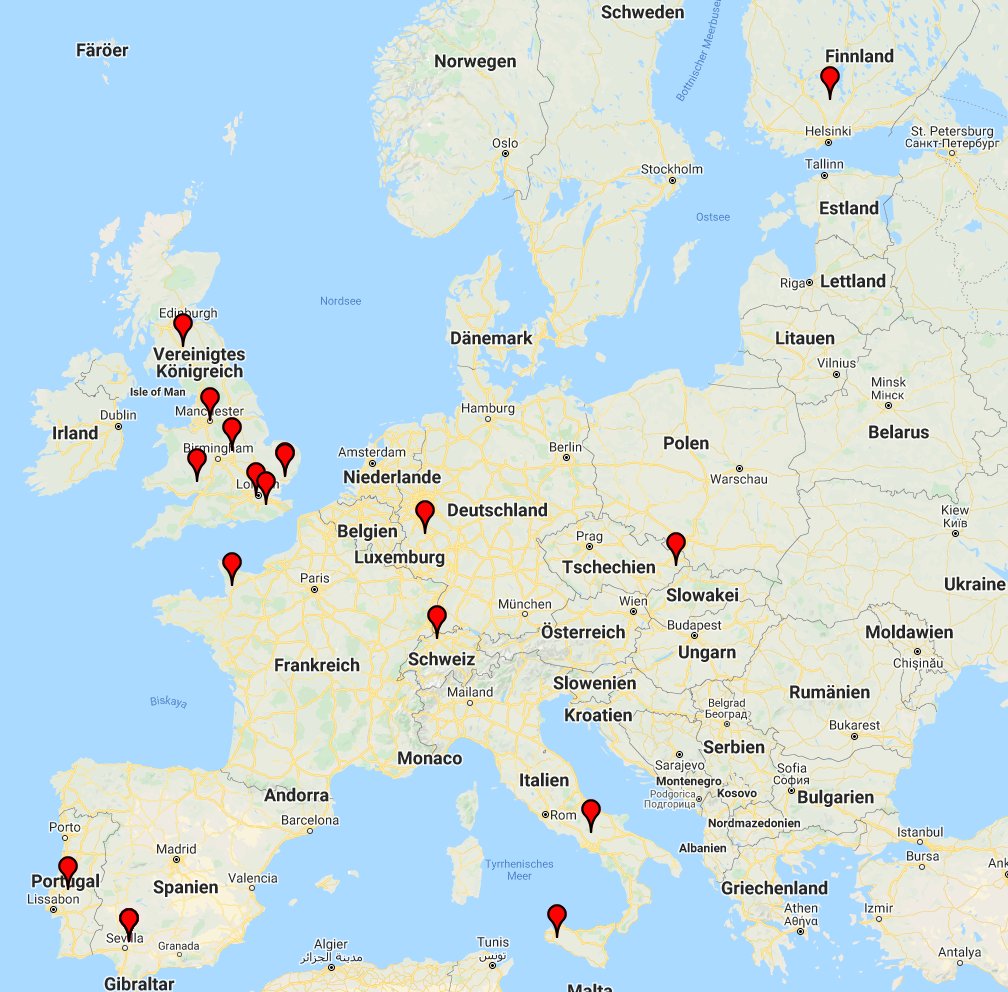 |
|
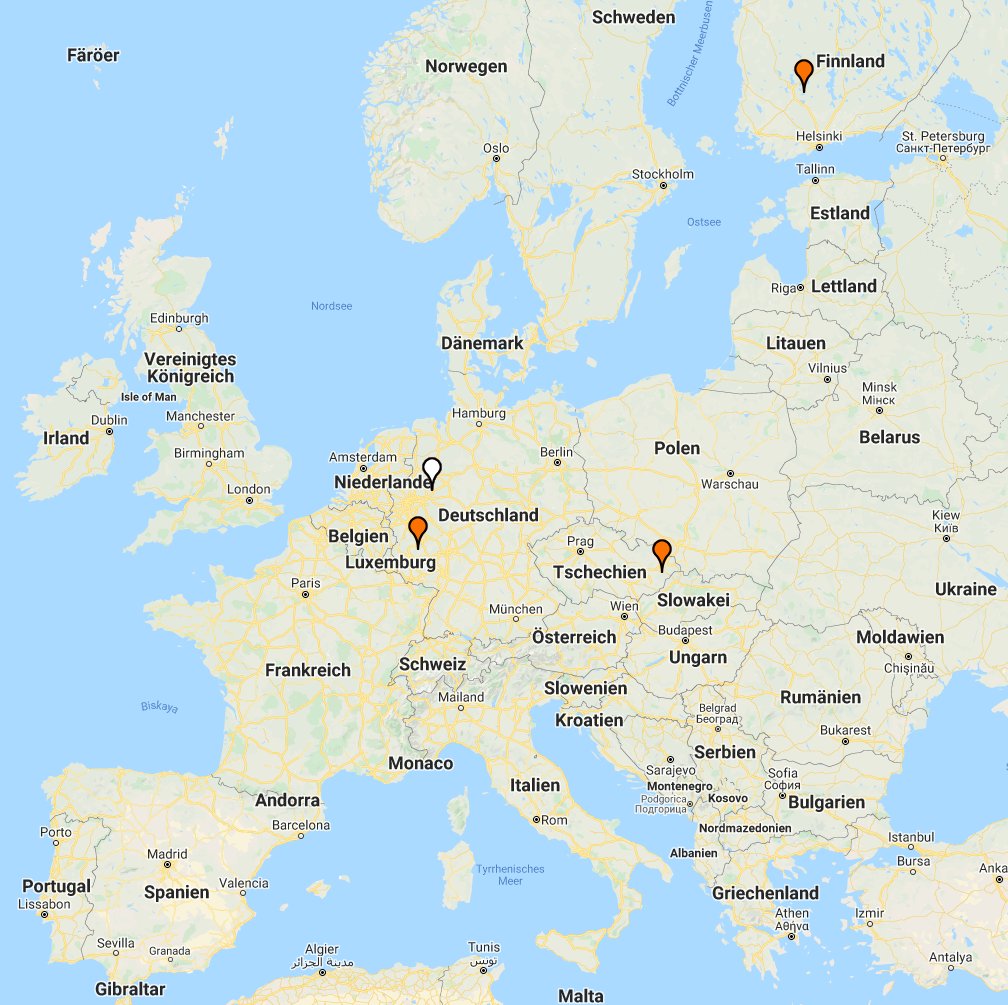 |
|
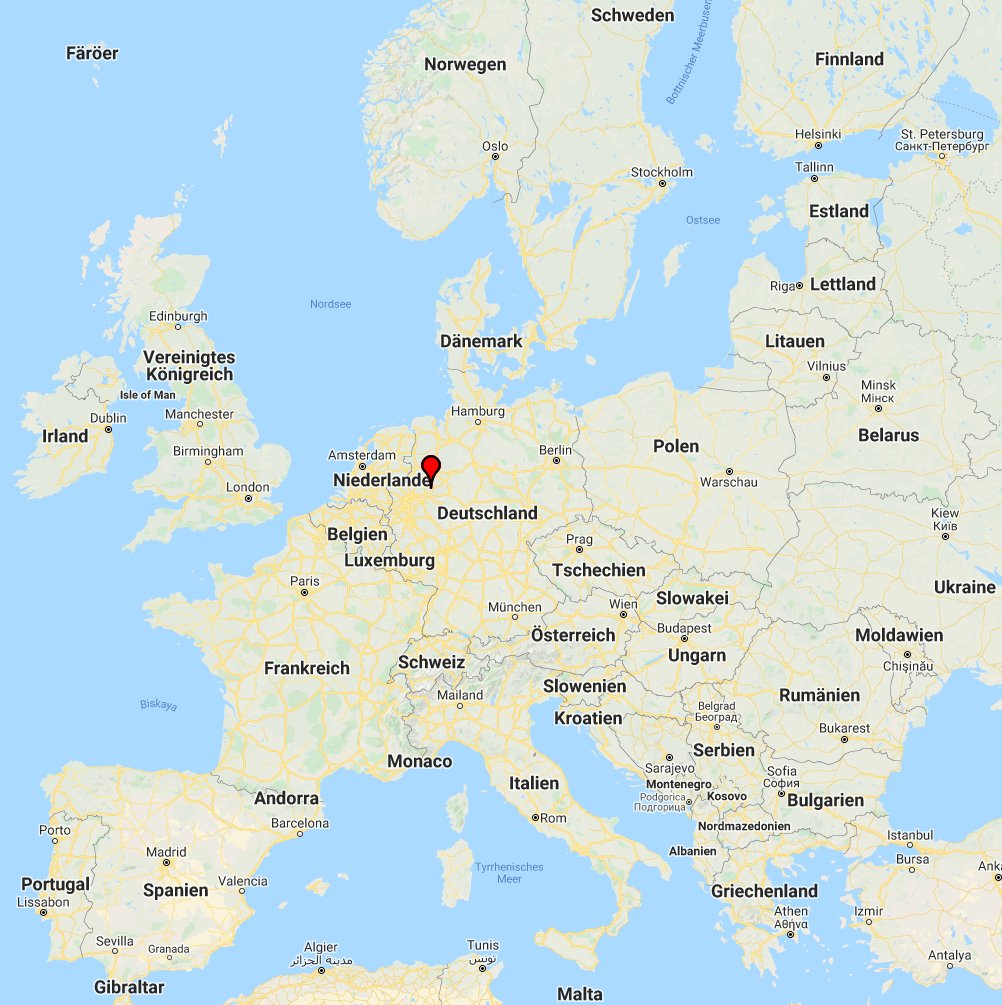 |
|
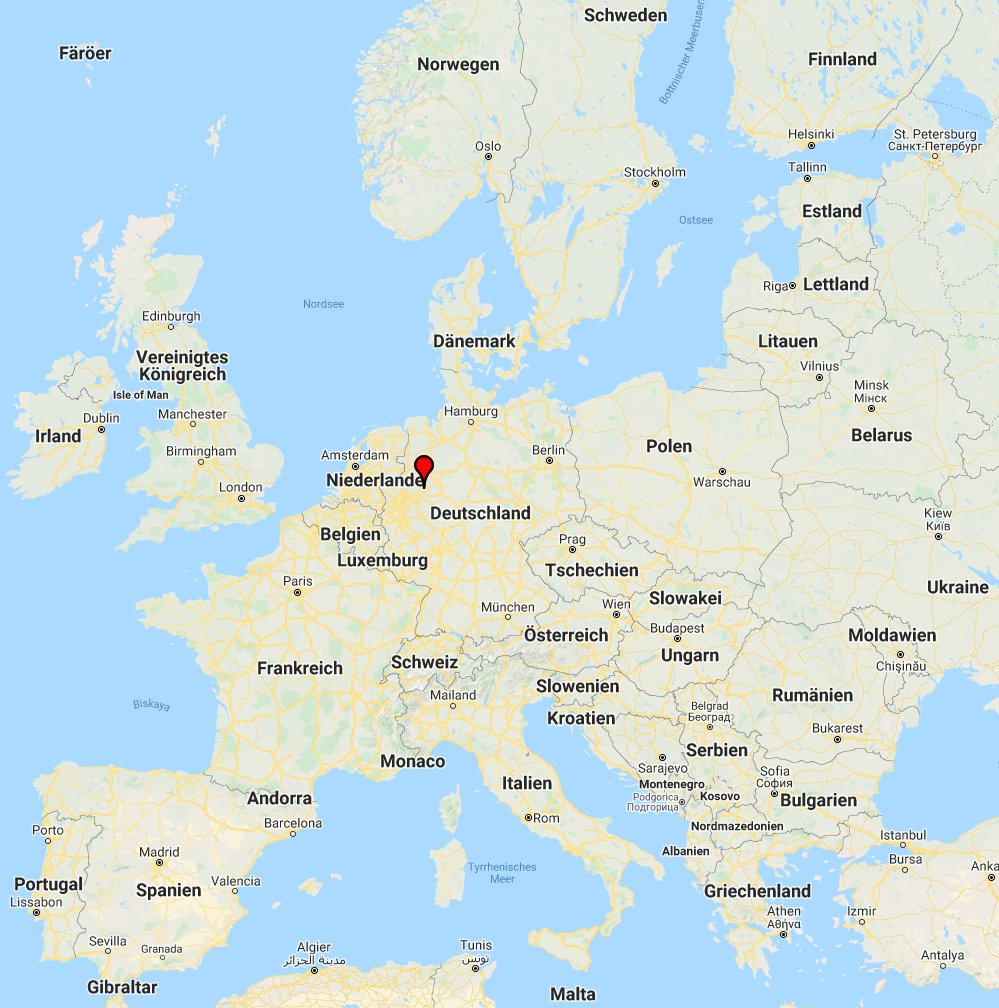 |
| MÜN_Uwe56 |
|
MÜN_Wern65 |
|
MÜN_Diet53 |
|
MÜN_Hugo62 |
|
|
| Probands Haplogroup R-M269 (Lower Saxony) |
Probands Haplogroup I-M170 (Eichsfeld) |
|
|
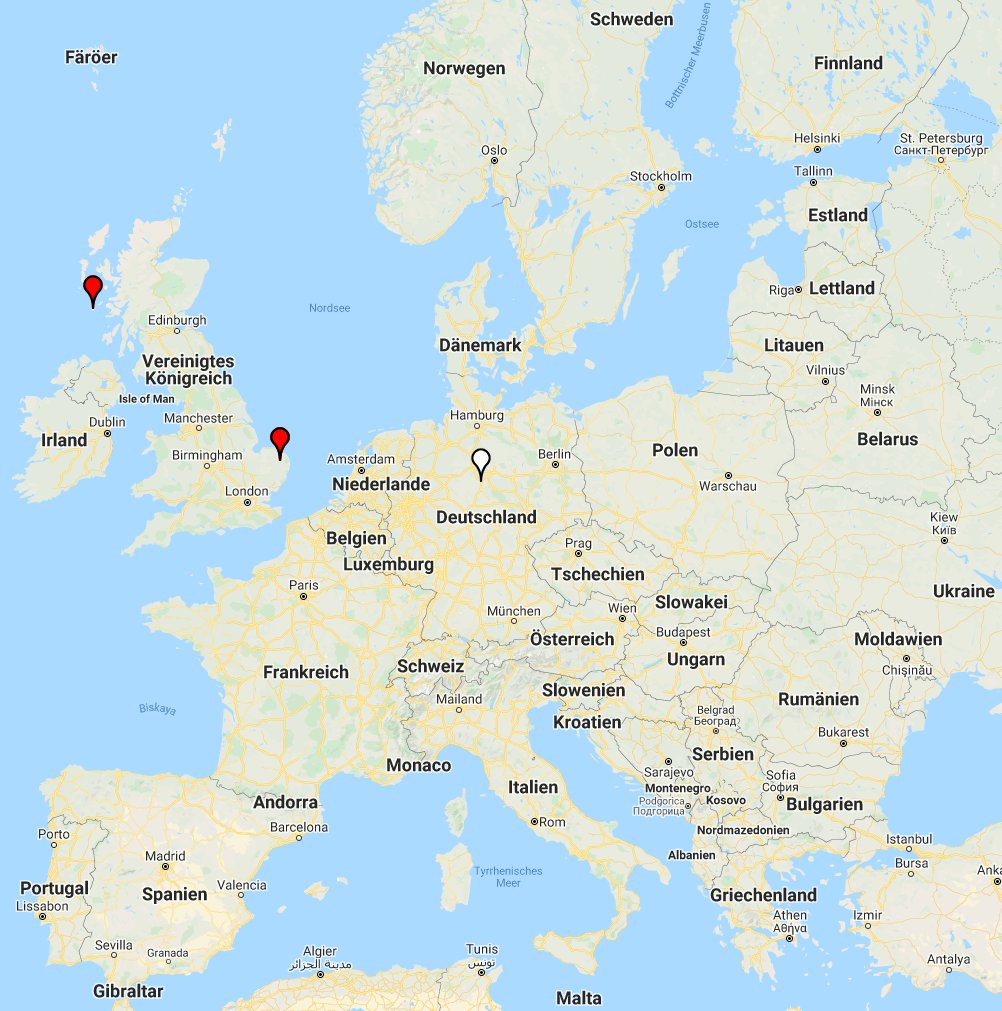 |
|
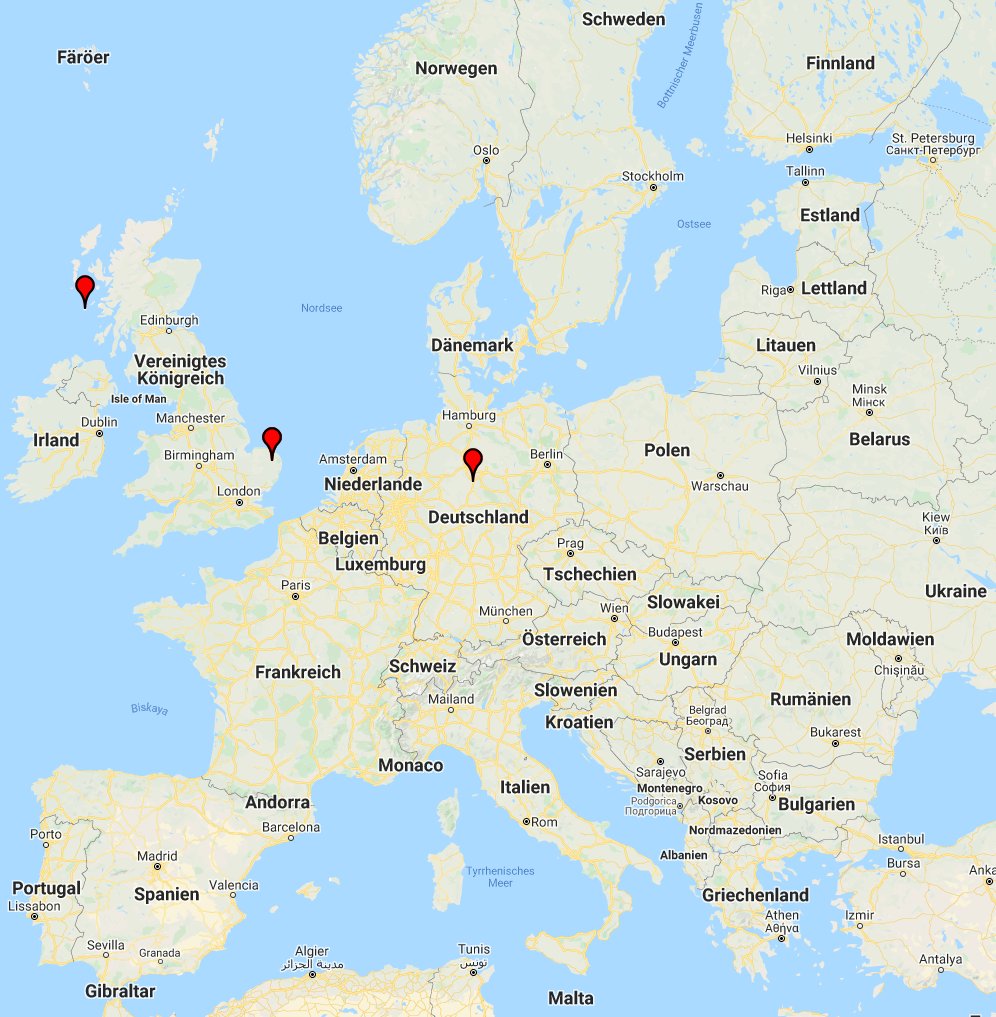 |
|
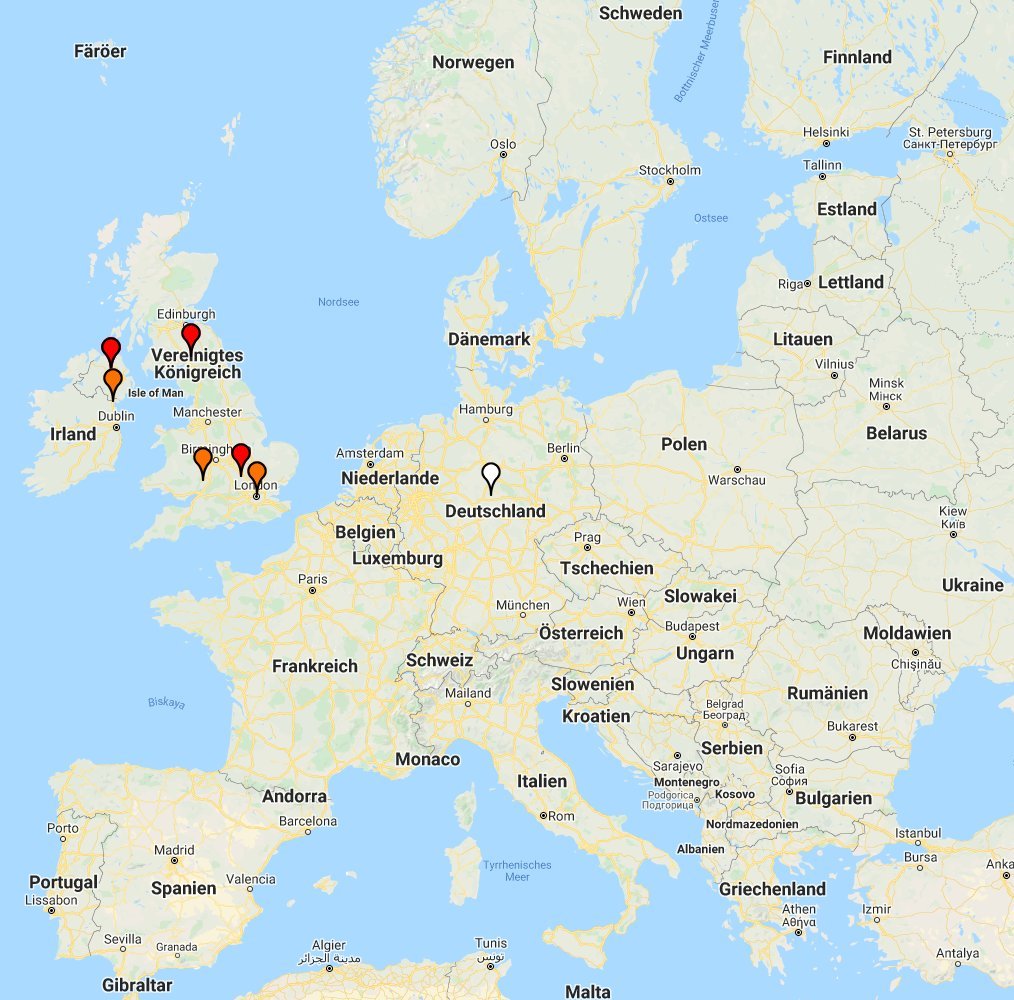
|
|
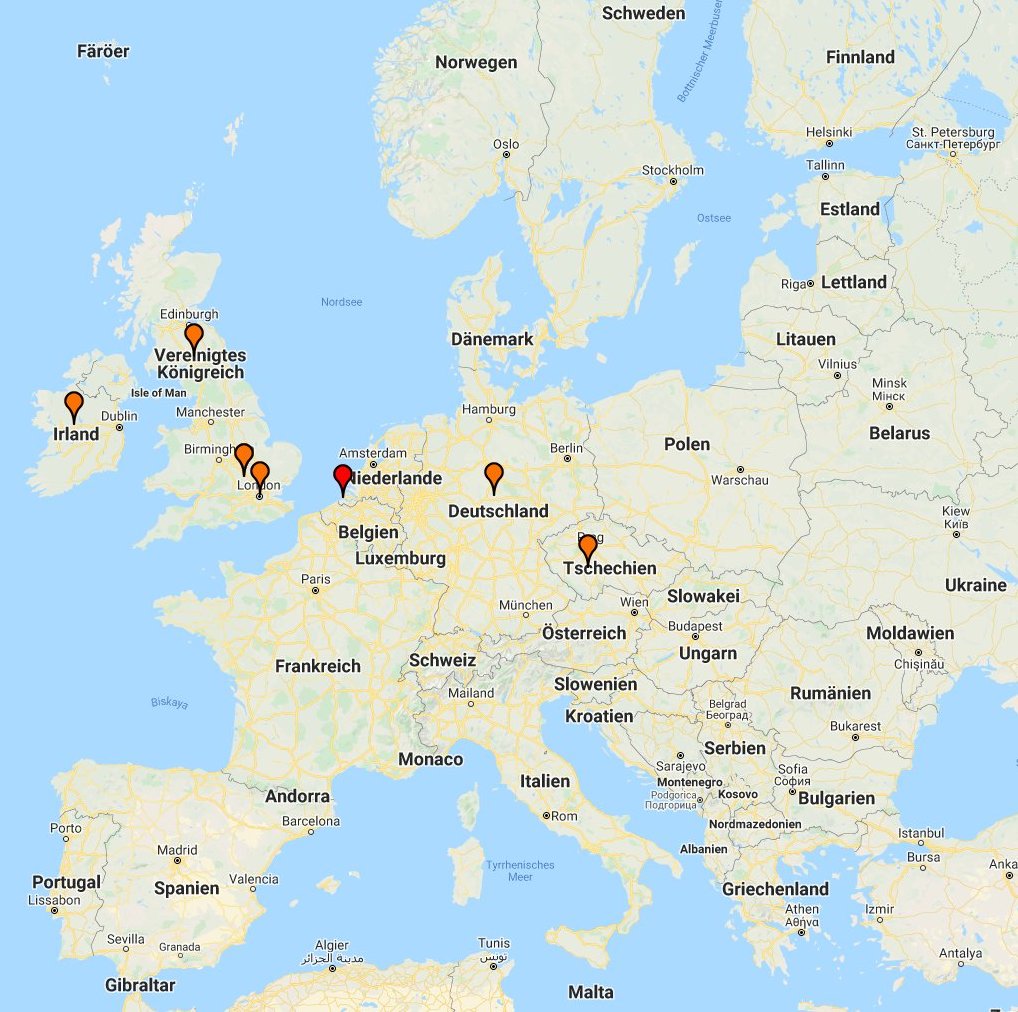 |
| SCH_Uwe61 |
|
BRA_Lutz40 |
|
NES_Stef60 |
|
WIN_Pete40 |
|
| Probands Haplogroup R-M198 (East Prussia
and Region Lüchow) |
|
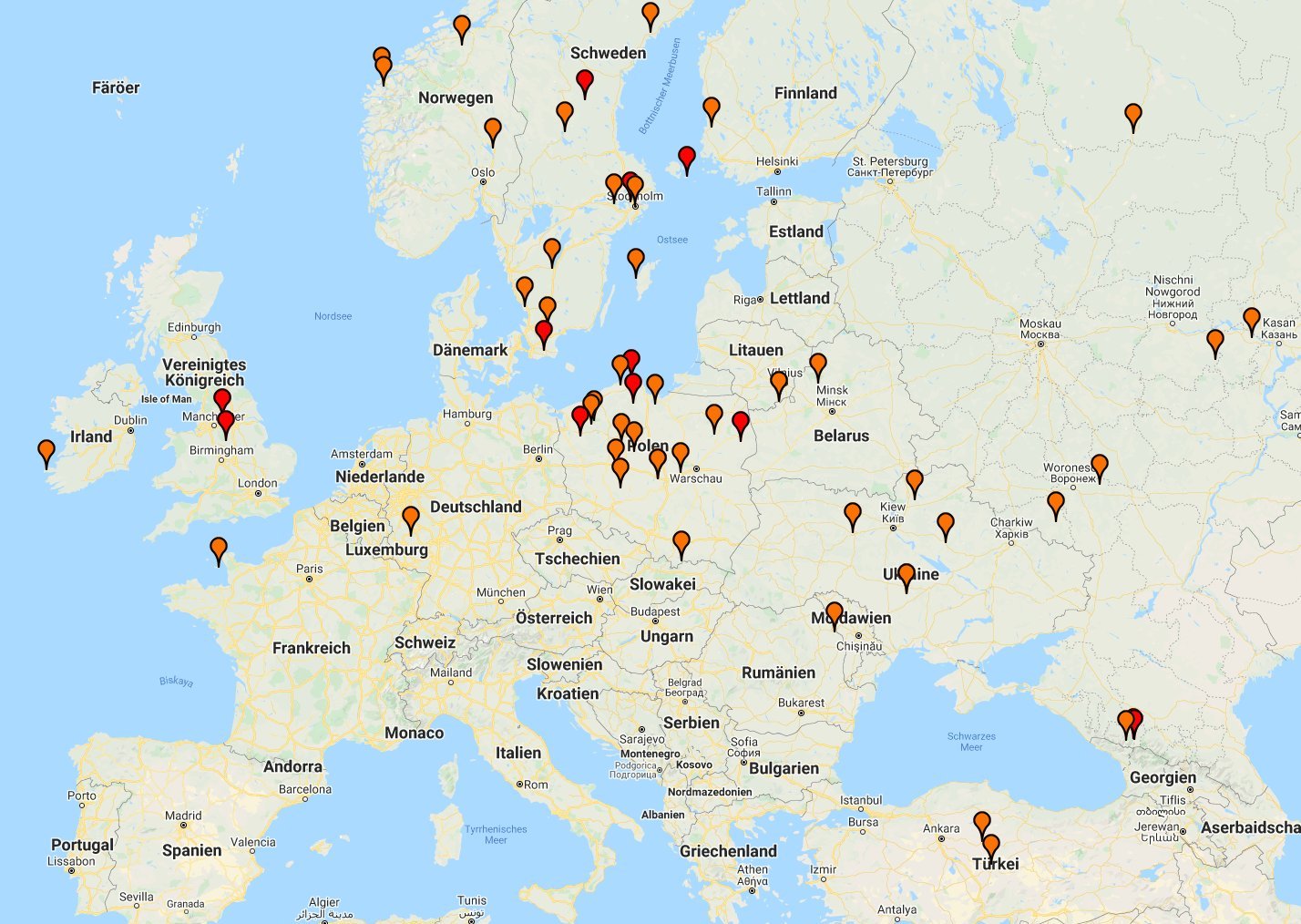
|
|
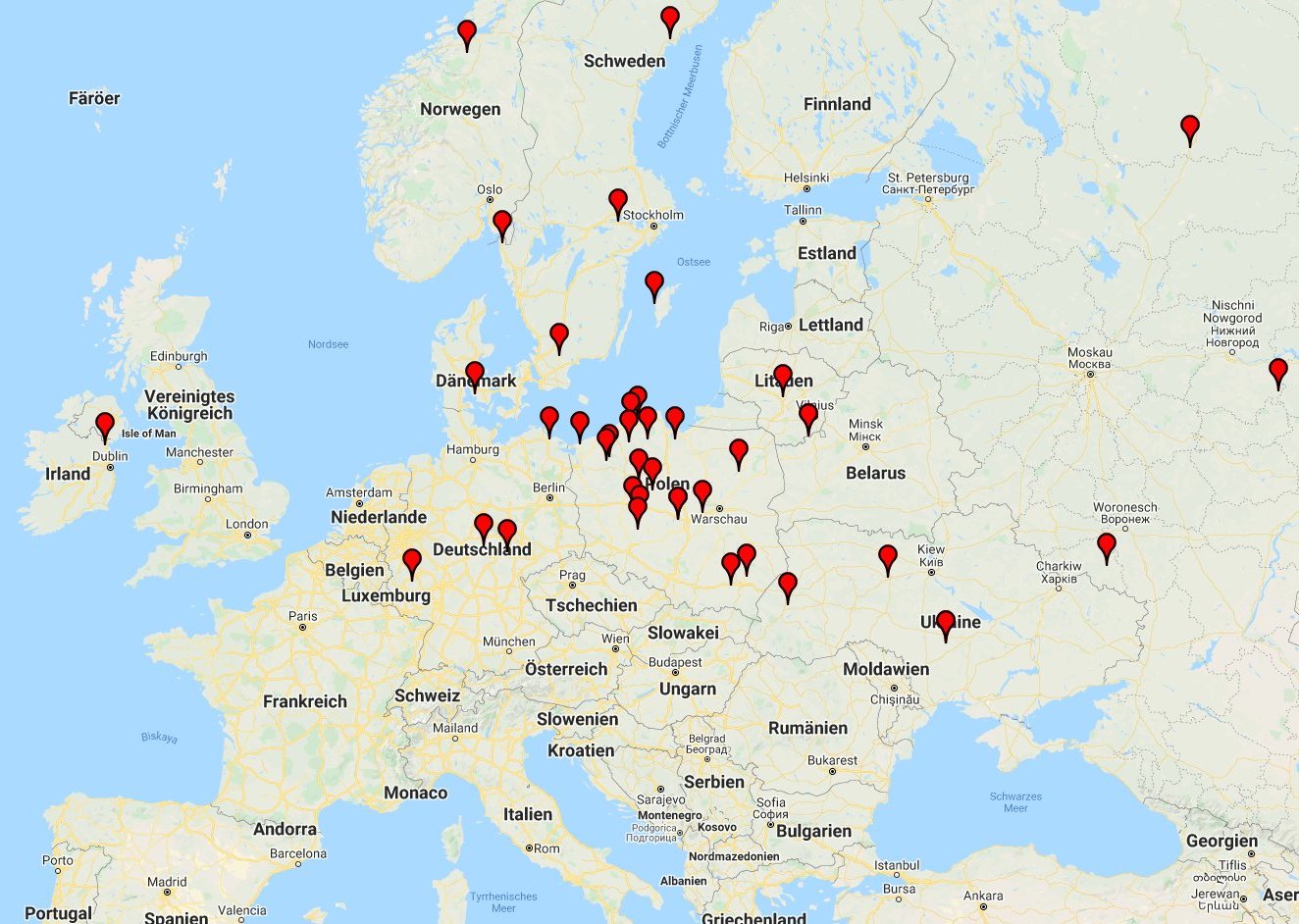
|
|
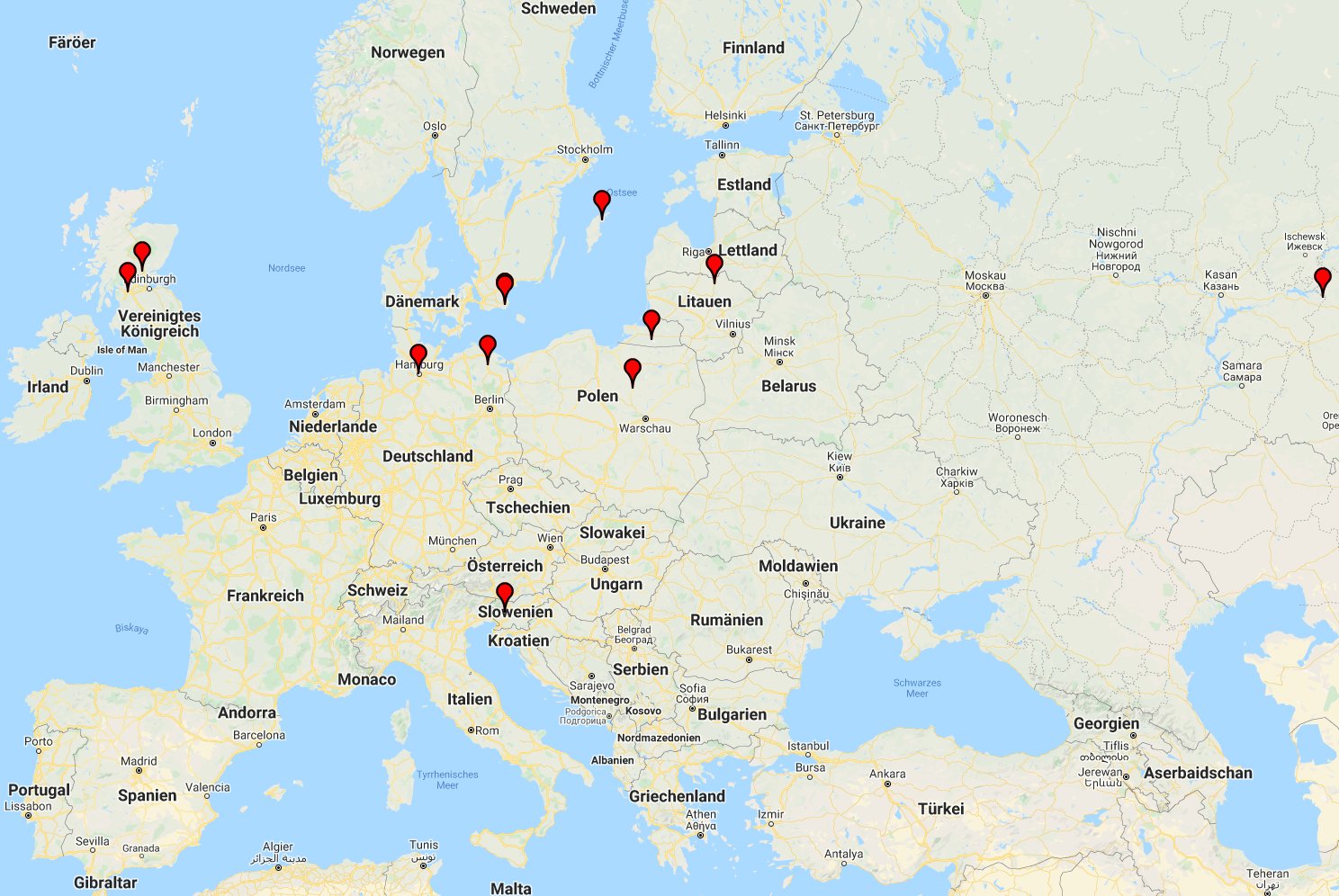 |
|
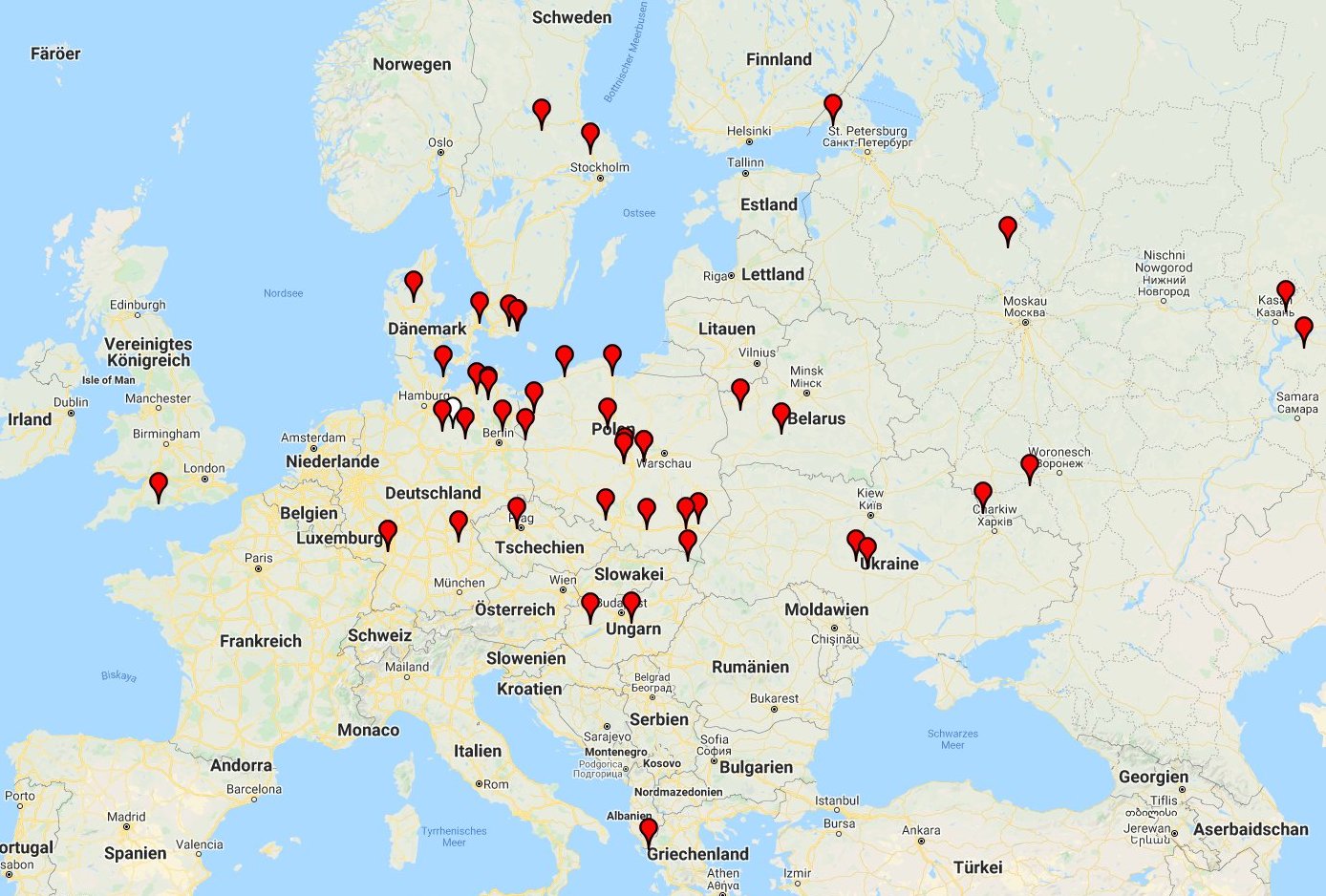
|
| KUS_Wern44 |
|
LIT_Olaf69 |
|
LIT_Manf49 |
|
LÜC_Holg56 |
|
| Probands Haplogroup Others |
|
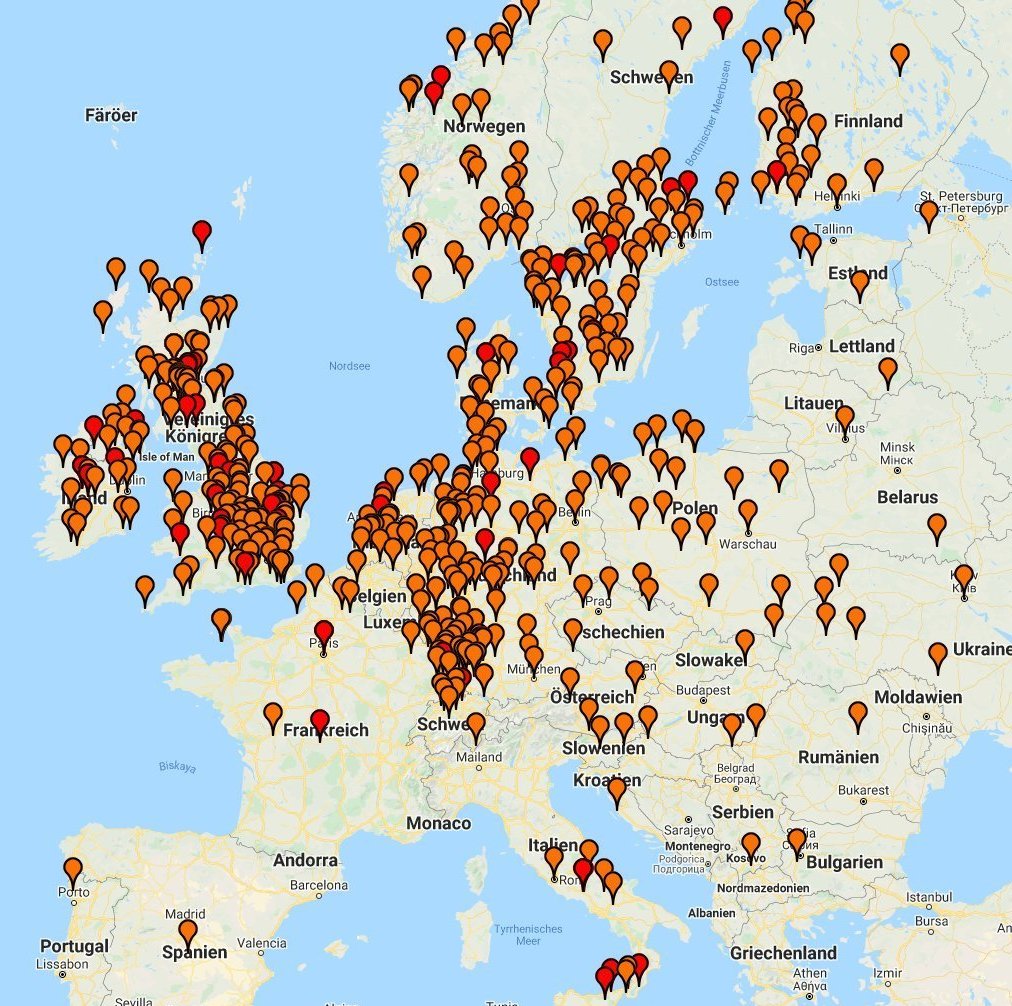 |
|
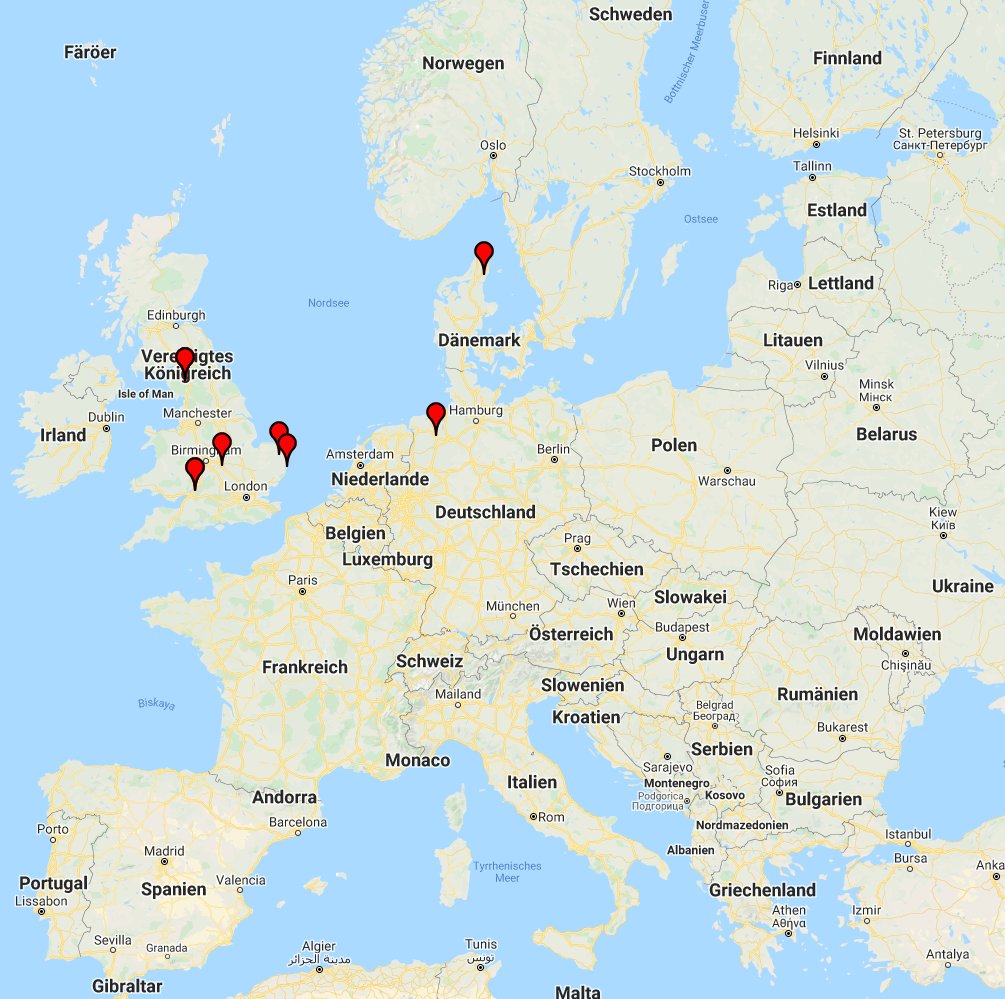 |
| STR_Rein60
(I-M253) |
|
MEC_Theo53
(R-M269) |
|
| The
project results are available at FamilyTreeDNA under the project group RITTMEIER / RITTMEYER. And if you
want to support the project, you can make a donation at FamilyTreeDNA
under the link DONATION. The donations will be
used to pay for further Y-DNA tests to advance the research here.
|
|
© 2022 www.familien-nachforschung.de.
All rights reserved. All statements without guarantee.
All data may be used for private purposes
of family research only.
(As of:14.02.2022) |
|